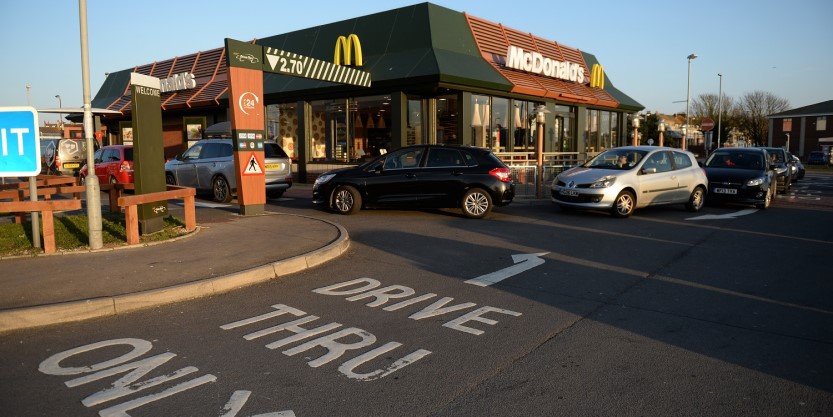Why drive-thrus are moving up a gear in COVID-19
Drive-thru shopping and drive-in entertainment are coming to the fore to help the retail and leisure sectors sustain income and remain relevant during COVID-19 social distancing
When Costa Coffee reopened one of its UK branches as drive-thru only in early May, the queue of cars stretched into the main road, with people happy to wait for their morning fix after a long wait in lockdown.
The drive-thru model isn’t just a lifeline for caffeine-seeking consumers looking for barista-made coffee. Across Europe, retailers and entertainment providers are exploring alternative ways to get business moving again as coronavirus lockdowns start to lift.
From Germany’s park-and-rave parties and Lithuania’s drive-in cinema, not to mention Denmark’s live concerts for cars, social distancing from behind the wheel is gaining popularity.
For those with retail real estate and large, empty car parks, creating drive-thru experiences could create exciting destinations while maintaining social distancing, says Dirk Wichner, JLL head of retail leasing in Germany.
“There are two main advantages – raising their profile by doing something different and also providing income during a very difficult time,” he explains. “For the mall operator, it may not be a significant direct income stream, but it will help speed up the process to bring them back up to normal footfall levels.”
In Germany, the Federal Network Agency has received a record number of applications for radio frequencies which transmit sound signal of films to car radios. Since the beginning of March, the authority has allocated 43 corresponding frequencies for drive-in cinemas nationwide, with a further 80 applications in process.
It’s a model the U.S. is already very familiar with. While the number of drive-in cinemas has fallen dramatically since their 1950s heyday, they have been making a comeback during the COVID-19 outbreak with 25 open at the end of April and more planning to welcome customers in the following weeks.
“At first sight, there’s a short-term, almost pop-up nature to this increase in interest but not all screening concepts will work,” says Wichner, who points to the limited enthusiasm among German football fans for recent screenings of Bundesliga games.
“Leisure activities need to be high quality to succeed.”
Collecting orders by car
More retailers are equally turning their attention to drive-thru collections.
Grocery stores like Auchan, Leclerc, Carrefour and Casino in France have long offered drive-thru collection points, but now other supermarket chains are following suit.
In May, Union Coop launched the Middle East’s first drive-thru grocery store in the UAE while in New Zealand, Countdown’s new “supermarket of the future” in Hamilton allows online shoppers to also have their shopping delivered directly to their car boot.
Yet what works in some countries isn’t a recipe for success in all – even in Covid-19 times. “Grocery retailers have tried many strategies in the past,” says Wichner. “But in Germany, major grocery stores have researched this and found that people like to select their own apples, hence the limited take up of, for example, click and collect.”
Fast food already has a long tradition of drive-thrus around the world but with many household names temporarily shutting during the outbreak, it’s become a popular first step back to normality. In the UK, McDonald’s, Starbucks and KFC, as well as Costa Coffee, set social media ablaze with news of their drive-thrus reopening – not to mention those queues that ensued.
It’s equally a strategy that the wider retail sector is now considering. Dixons Carphone in the UK, for example, is exploring designated drive-thru pick-up points outside some stores.
“When compared with its continental European neighbours, the UK already has a strong online delivery system,” says Tim Vallance, head of UK investor services and retail chairman at JLL. “But that has not automatically correlated with drive-thru innovation. The current COVID-19 situation could spur wider roll-out of pick-up points.”
Lessons from past crises
The retail sector’s reaction to COVID-19 measures has been quicker than in 2008, says Emma Tattersall, director, European retail capital markets at JLL.
“There was, of course, a response to loss of footfall following the global financial crisis such as bringing in more F&B and increasing leisure attractions, but it came late,” says Tattersall. “Owners now need to think very quickly and innovatively. Drive-in entertainment nights and drive-thru food could be combined with other click-and-collect services.”
Malls could look at one dedicated collection point for all retailers - or even for those without a store on site, she adds, following the example of Westfield malls in New Zealand with their drive-thru click-and-collect services in basement car parks.
And while most retailers are currently trying to get through the next few months, there’s equally the potential to create longer-term change.
“From rethinking the use of currently empty space to getting goods ordered online to consumers in other ways than home delivery, retailers need to get creative when times are tough,” Wichner says. “The speed of recovery from COVID-19 will determine how long these strategies last.”

